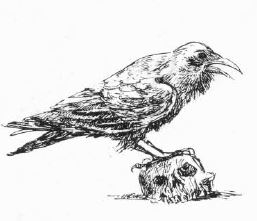This month, the Fiend Factory takes a loose theme of small (or Tiny) monsters, under the title of “Little Things”. Of note is that the Monstermark rating is finally dropped, since the XP-based system from the DMG has long superceded this mostly out-of-print (and complicated) method of calculating a monster’s threat rating. It isn’t, however, replaced with any other indication of challenge rating, and so from hereon the DM is kind of left adrift to eyeball how tough any given monster is.
First up is the Greater Raven, from the stalwart Roger E Moore.
For something so rife in folklore and myth (not to mention fantasy works from Tolkien to Robert Jordan), this is a surprisingly overlooked concept. Basically, though, just take a standard raven stats and give it Intelligence and language (and, in this case, a good Perception and Stealth score), and that’s pretty much it.
A very odd creature is the Qothe
(pronounced Koh-Thuh), and the name Bob Greenwade doesn’t ring any bells, I don't think he's had anything else published.
They travel by bouncing, feed on blood, and can detect platinum and gems, even through barriers. Their main game function, however, is either as a source of ingredients for various potions, or as an unusual type of familiar; the master gains some of the powers of the qothe including the treasure finding and improved jumping ability. I quite like them, they'd be good background flavour especially in a different plane or other planet.
The Wyrmlet, by another novel contributer, Peter Ryding, is a disc-shaped creature that is, effectively, one segment of a large worm-like gestalt, called a wyrmling.
I can’t decide if I think it’s a clever or stupid idea. They’re very weird, and perhaps pretty goofy looking, but I also quite like the concept of monsters that join together, Gundam-style, to form a bigger monster. The wyrmling needs a “head” unit to form, but not then to stay together, and when combined the creature can create a kind of disintegration ray by vibrating along the length of its body. “Head” wyrmlets also tend to have spellcasting abilities.
Lastly we get the Mara, and again I don’t recall seeing Simon Craddock’s name before. Welcome to the Fiend Factory club.
These are kind of like an evil counterpart to sprites (and so I’d class them as fey). They’ve got (again) good Stealth ability, darkvision and light sensitivity, as well as a venomous bite that causes nausea (i.e. the poisoned condition). Most of the mara’s description is taken up with some complex sub-rules about hitting its wings. It’s okay, but I don’t know what novelty it really brings to the table. A tiny flying venomous thing? From wasps to imps, there are plenty to chose from already.And so, much as the most novel creatures here are the qothe and the wyrmlet, I’ve gone with Phil Master’s Nightling. It’s not a million miles from the mara in terms of what we get, but is just that bit more interesting, yet not as bafflingly bizarre as the qothe and wyrmlet, to make it yet another addition to the tiny pest monster collection.
|
Nightling |
||||||||||||
|
Tiny humanoid (nightling), neutral evil |
||||||||||||
|
Armour Class 13 (natural armour) Hit Points 3 (1d4 + 1) Speed 20 ft. |
||||||||||||
|
||||||||||||
|
Proficiency Bonus +2 Skills Animal Handling +1, Stealth +6 Senses darkvision 120 ft., passive
Perception 11 |
||||||||||||
|
Languages Troglodyte, Undercommon |
||||||||||||
|
Challenge 1/4 (50 XP) |
||||||||||||
|
Chameleon
Skin. The nightling has advantage on Dexterity (Stealth) checks to
hide. Sunlight
Sensitivity. While in sunlight, the nightling has disadvantage on attack
rolls, as well as Wisdom (Perception) checks that rely on sight. Troglodyte
Affinity. The nightling is immune to a troglodyte’s Stench. Innate Spellcasting. The nightling’s innate spellcasting ability is
Wisdom (save DC 11). It can innately cast the following spells without
material components. ACTIONS |
||||||||||||
|
Claw. Melee Weapon Attack:
+4 to hit, reach 5 ft., one creature. Hit:
1 slashing damage. Dart. Ranged Weapon Attack:
+4 to hit, range 20/30 ft., one creature. Hit:
1 piercing damage, and if the target is a living creature it must make a DC
12 Constitution saving throw or become paralysed. A paralysed creature can
repeat the saving throw at the end of each of its subsequent turns, ending
the effect on itself on a success. REACTIONS |
||||||||||||
|
Evasion.
If the nightling is subjected to an effect that allows it to make a Dexterity
saving throw to avoid damage, it takes no damage on a successful save, and
half damage on a failed save. |
Nightling Leader
Innate Spellcasting. The nightling’s innate spellcasting ability is
Wisdom (save DC 11). It can innately cast the following spells without material
components.
2/day each: cure wounds (self only), darkness, detect magic, minor illusion
1/day each: dispel magic, magic missile (as 3rd
level spell slot)













Comments
Post a Comment